Starbucks: Evaluating Organizational Strategy and Performance
VerifiedAdded on 2020/12/31
|13
|4223
|433
Report
AI Summary
This report offers a detailed analysis of Starbucks' organizational strategy, examining its key components and their impact on the company's performance. It begins by outlining Starbucks' core strategies, including being an employer of choice, coffee leadership, store portfolio growth, new occasion creation, consumer product brand growth, building Teavana, and extended digital engagement. The report then assesses Starbucks' financial performance, highlighting both successes and challenges, particularly during the 2008 GFC. A PESTLE analysis is conducted to evaluate the external environment, identifying political, economic, social, technological, environmental, and legal factors influencing the company. Furthermore, a SWOT analysis is presented to assess Starbucks' strengths, weaknesses, opportunities, and threats. Finally, the report examines the company's resources and capabilities, emphasizing their role in achieving a competitive advantage. Overall, the report provides a comprehensive understanding of Starbucks' strategic approach and its alignment with the internal and external environment.
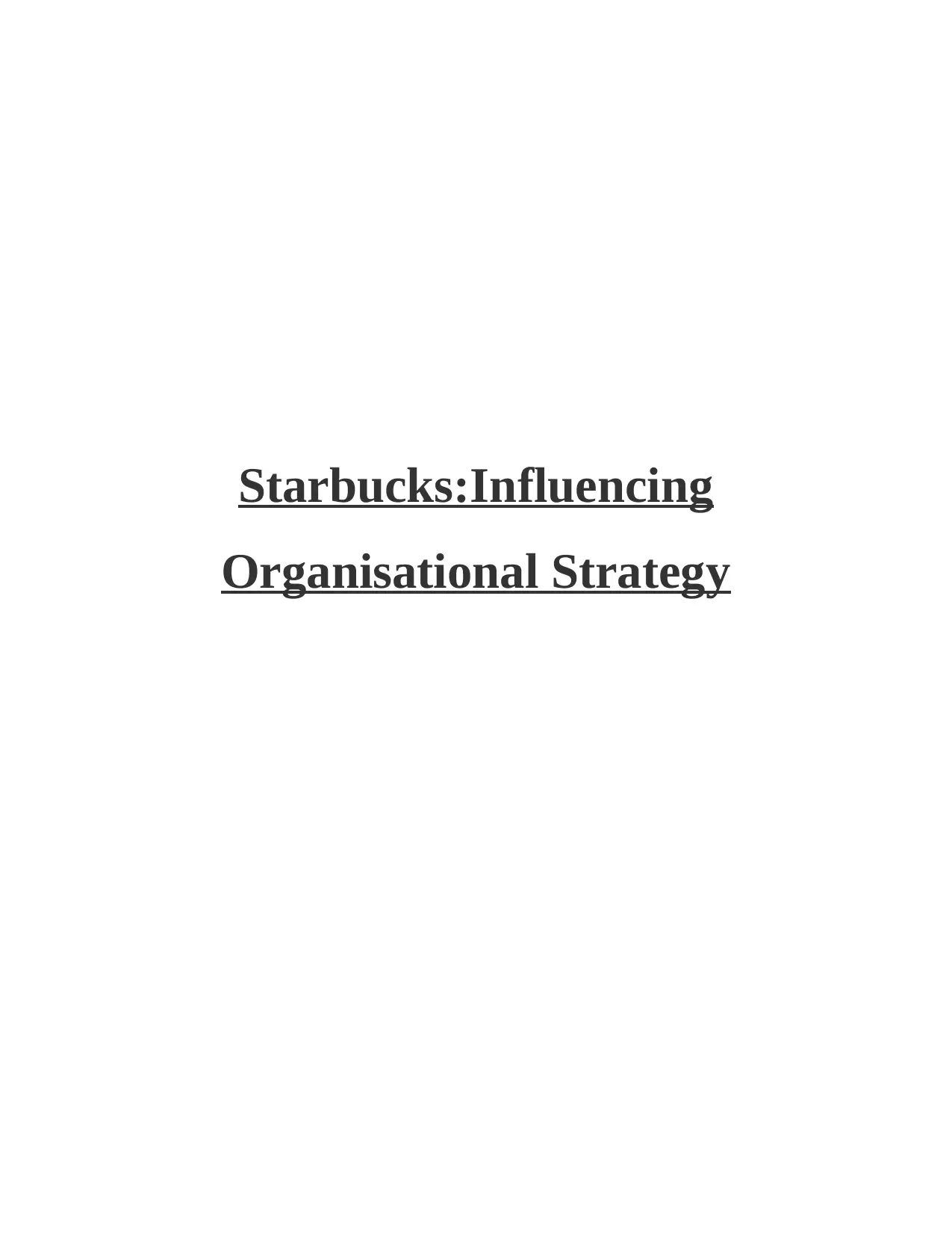
Starbucks:Influencing
Organisational Strategy
Organisational Strategy
Paraphrase This Document
Need a fresh take? Get an instant paraphrase of this document with our AI Paraphraser
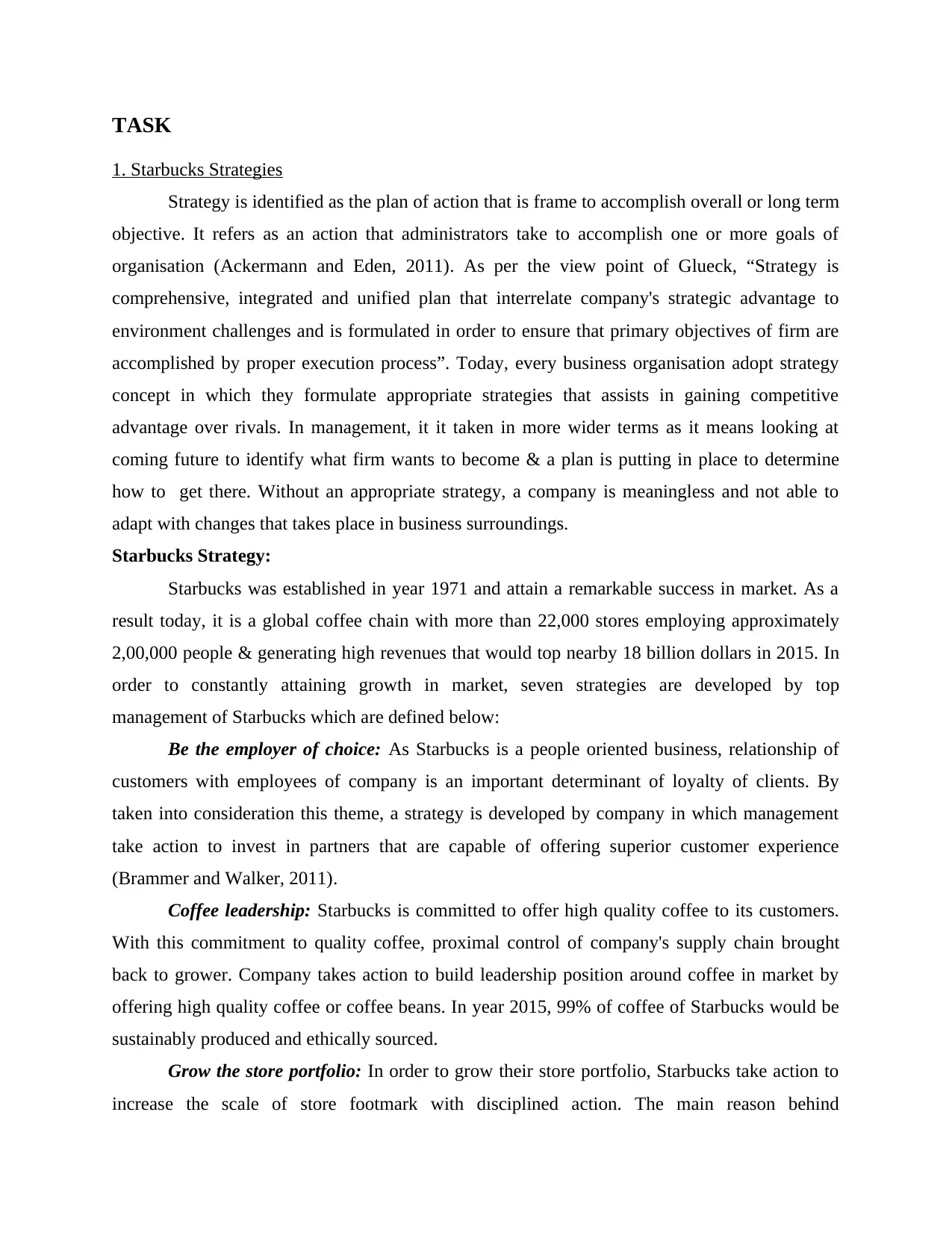
TASK
1. Starbucks Strategies
Strategy is identified as the plan of action that is frame to accomplish overall or long term
objective. It refers as an action that administrators take to accomplish one or more goals of
organisation (Ackermann and Eden, 2011). As per the view point of Glueck, “Strategy is
comprehensive, integrated and unified plan that interrelate company's strategic advantage to
environment challenges and is formulated in order to ensure that primary objectives of firm are
accomplished by proper execution process”. Today, every business organisation adopt strategy
concept in which they formulate appropriate strategies that assists in gaining competitive
advantage over rivals. In management, it it taken in more wider terms as it means looking at
coming future to identify what firm wants to become & a plan is putting in place to determine
how to get there. Without an appropriate strategy, a company is meaningless and not able to
adapt with changes that takes place in business surroundings.
Starbucks Strategy:
Starbucks was established in year 1971 and attain a remarkable success in market. As a
result today, it is a global coffee chain with more than 22,000 stores employing approximately
2,00,000 people & generating high revenues that would top nearby 18 billion dollars in 2015. In
order to constantly attaining growth in market, seven strategies are developed by top
management of Starbucks which are defined below:
Be the employer of choice: As Starbucks is a people oriented business, relationship of
customers with employees of company is an important determinant of loyalty of clients. By
taken into consideration this theme, a strategy is developed by company in which management
take action to invest in partners that are capable of offering superior customer experience
(Brammer and Walker, 2011).
Coffee leadership: Starbucks is committed to offer high quality coffee to its customers.
With this commitment to quality coffee, proximal control of company's supply chain brought
back to grower. Company takes action to build leadership position around coffee in market by
offering high quality coffee or coffee beans. In year 2015, 99% of coffee of Starbucks would be
sustainably produced and ethically sourced.
Grow the store portfolio: In order to grow their store portfolio, Starbucks take action to
increase the scale of store footmark with disciplined action. The main reason behind
1. Starbucks Strategies
Strategy is identified as the plan of action that is frame to accomplish overall or long term
objective. It refers as an action that administrators take to accomplish one or more goals of
organisation (Ackermann and Eden, 2011). As per the view point of Glueck, “Strategy is
comprehensive, integrated and unified plan that interrelate company's strategic advantage to
environment challenges and is formulated in order to ensure that primary objectives of firm are
accomplished by proper execution process”. Today, every business organisation adopt strategy
concept in which they formulate appropriate strategies that assists in gaining competitive
advantage over rivals. In management, it it taken in more wider terms as it means looking at
coming future to identify what firm wants to become & a plan is putting in place to determine
how to get there. Without an appropriate strategy, a company is meaningless and not able to
adapt with changes that takes place in business surroundings.
Starbucks Strategy:
Starbucks was established in year 1971 and attain a remarkable success in market. As a
result today, it is a global coffee chain with more than 22,000 stores employing approximately
2,00,000 people & generating high revenues that would top nearby 18 billion dollars in 2015. In
order to constantly attaining growth in market, seven strategies are developed by top
management of Starbucks which are defined below:
Be the employer of choice: As Starbucks is a people oriented business, relationship of
customers with employees of company is an important determinant of loyalty of clients. By
taken into consideration this theme, a strategy is developed by company in which management
take action to invest in partners that are capable of offering superior customer experience
(Brammer and Walker, 2011).
Coffee leadership: Starbucks is committed to offer high quality coffee to its customers.
With this commitment to quality coffee, proximal control of company's supply chain brought
back to grower. Company takes action to build leadership position around coffee in market by
offering high quality coffee or coffee beans. In year 2015, 99% of coffee of Starbucks would be
sustainably produced and ethically sourced.
Grow the store portfolio: In order to grow their store portfolio, Starbucks take action to
increase the scale of store footmark with disciplined action. The main reason behind
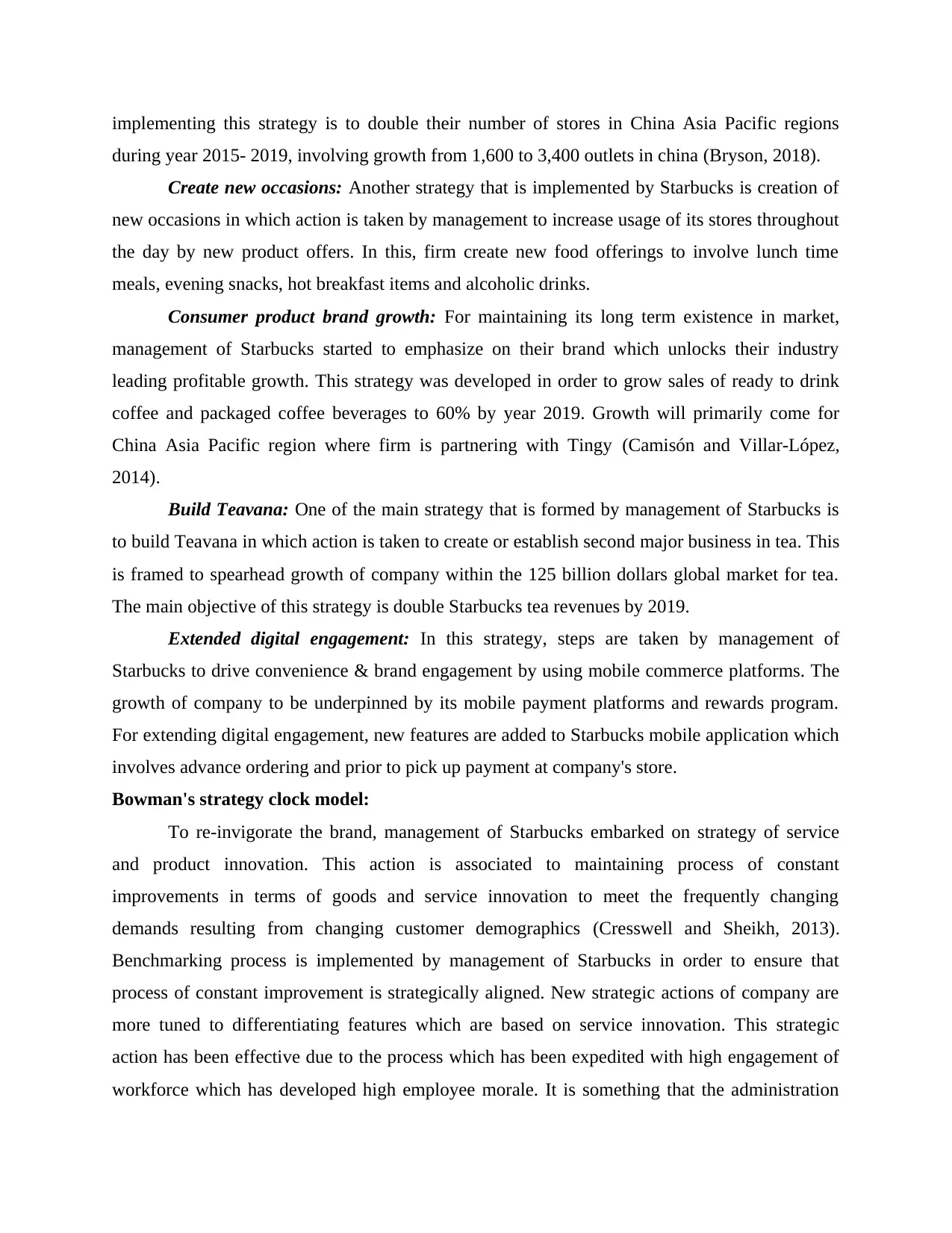
implementing this strategy is to double their number of stores in China Asia Pacific regions
during year 2015- 2019, involving growth from 1,600 to 3,400 outlets in china (Bryson, 2018).
Create new occasions: Another strategy that is implemented by Starbucks is creation of
new occasions in which action is taken by management to increase usage of its stores throughout
the day by new product offers. In this, firm create new food offerings to involve lunch time
meals, evening snacks, hot breakfast items and alcoholic drinks.
Consumer product brand growth: For maintaining its long term existence in market,
management of Starbucks started to emphasize on their brand which unlocks their industry
leading profitable growth. This strategy was developed in order to grow sales of ready to drink
coffee and packaged coffee beverages to 60% by year 2019. Growth will primarily come for
China Asia Pacific region where firm is partnering with Tingy (Camisón and Villar-López,
2014).
Build Teavana: One of the main strategy that is formed by management of Starbucks is
to build Teavana in which action is taken to create or establish second major business in tea. This
is framed to spearhead growth of company within the 125 billion dollars global market for tea.
The main objective of this strategy is double Starbucks tea revenues by 2019.
Extended digital engagement: In this strategy, steps are taken by management of
Starbucks to drive convenience & brand engagement by using mobile commerce platforms. The
growth of company to be underpinned by its mobile payment platforms and rewards program.
For extending digital engagement, new features are added to Starbucks mobile application which
involves advance ordering and prior to pick up payment at company's store.
Bowman's strategy clock model:
To re-invigorate the brand, management of Starbucks embarked on strategy of service
and product innovation. This action is associated to maintaining process of constant
improvements in terms of goods and service innovation to meet the frequently changing
demands resulting from changing customer demographics (Cresswell and Sheikh, 2013).
Benchmarking process is implemented by management of Starbucks in order to ensure that
process of constant improvement is strategically aligned. New strategic actions of company are
more tuned to differentiating features which are based on service innovation. This strategic
action has been effective due to the process which has been expedited with high engagement of
workforce which has developed high employee morale. It is something that the administration
during year 2015- 2019, involving growth from 1,600 to 3,400 outlets in china (Bryson, 2018).
Create new occasions: Another strategy that is implemented by Starbucks is creation of
new occasions in which action is taken by management to increase usage of its stores throughout
the day by new product offers. In this, firm create new food offerings to involve lunch time
meals, evening snacks, hot breakfast items and alcoholic drinks.
Consumer product brand growth: For maintaining its long term existence in market,
management of Starbucks started to emphasize on their brand which unlocks their industry
leading profitable growth. This strategy was developed in order to grow sales of ready to drink
coffee and packaged coffee beverages to 60% by year 2019. Growth will primarily come for
China Asia Pacific region where firm is partnering with Tingy (Camisón and Villar-López,
2014).
Build Teavana: One of the main strategy that is formed by management of Starbucks is
to build Teavana in which action is taken to create or establish second major business in tea. This
is framed to spearhead growth of company within the 125 billion dollars global market for tea.
The main objective of this strategy is double Starbucks tea revenues by 2019.
Extended digital engagement: In this strategy, steps are taken by management of
Starbucks to drive convenience & brand engagement by using mobile commerce platforms. The
growth of company to be underpinned by its mobile payment platforms and rewards program.
For extending digital engagement, new features are added to Starbucks mobile application which
involves advance ordering and prior to pick up payment at company's store.
Bowman's strategy clock model:
To re-invigorate the brand, management of Starbucks embarked on strategy of service
and product innovation. This action is associated to maintaining process of constant
improvements in terms of goods and service innovation to meet the frequently changing
demands resulting from changing customer demographics (Cresswell and Sheikh, 2013).
Benchmarking process is implemented by management of Starbucks in order to ensure that
process of constant improvement is strategically aligned. New strategic actions of company are
more tuned to differentiating features which are based on service innovation. This strategic
action has been effective due to the process which has been expedited with high engagement of
workforce which has developed high employee morale. It is something that the administration
⊘ This is a preview!⊘
Do you want full access?
Subscribe today to unlock all pages.

Trusted by 1+ million students worldwide
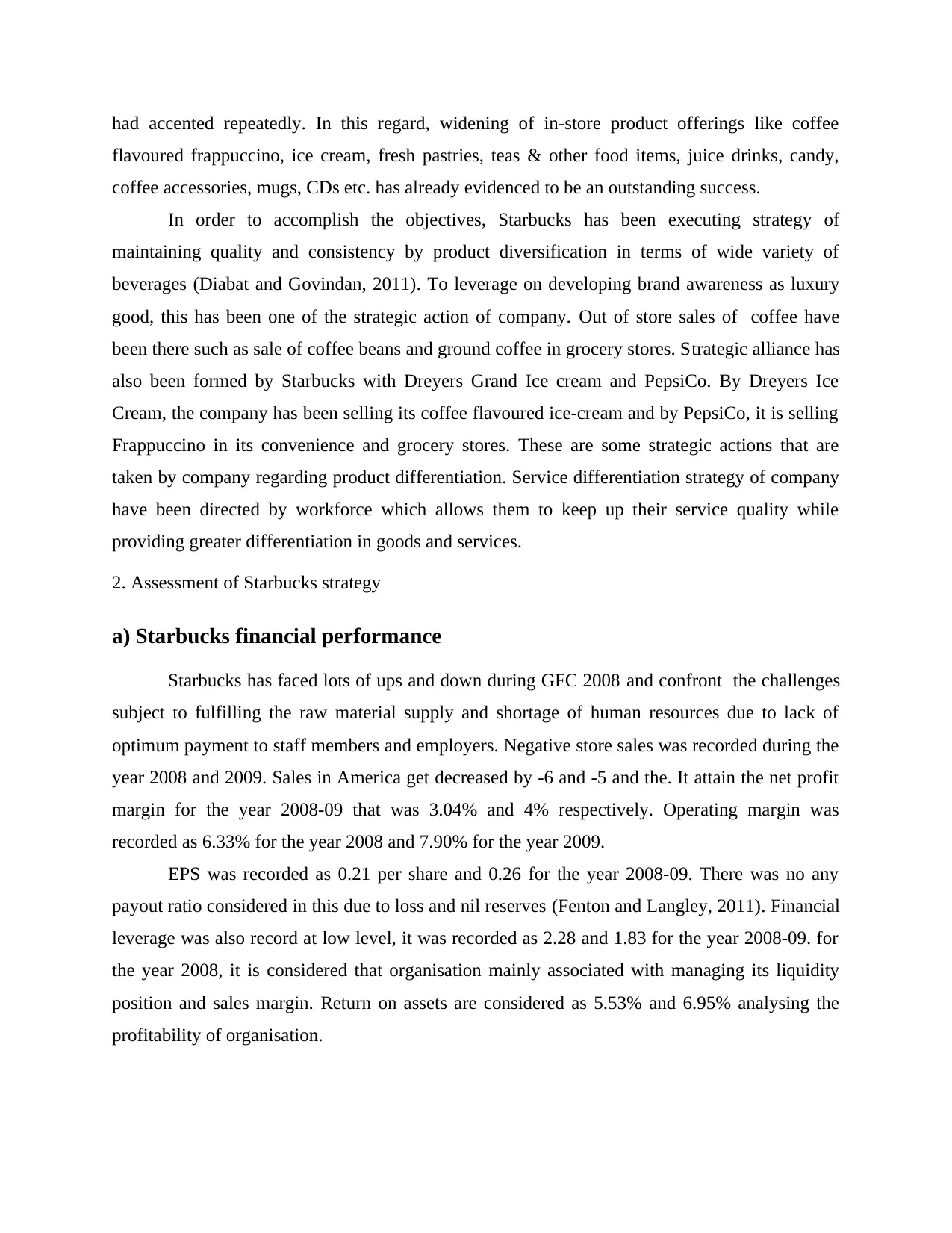
had accented repeatedly. In this regard, widening of in-store product offerings like coffee
flavoured frappuccino, ice cream, fresh pastries, teas & other food items, juice drinks, candy,
coffee accessories, mugs, CDs etc. has already evidenced to be an outstanding success.
In order to accomplish the objectives, Starbucks has been executing strategy of
maintaining quality and consistency by product diversification in terms of wide variety of
beverages (Diabat and Govindan, 2011). To leverage on developing brand awareness as luxury
good, this has been one of the strategic action of company. Out of store sales of coffee have
been there such as sale of coffee beans and ground coffee in grocery stores. Strategic alliance has
also been formed by Starbucks with Dreyers Grand Ice cream and PepsiCo. By Dreyers Ice
Cream, the company has been selling its coffee flavoured ice-cream and by PepsiCo, it is selling
Frappuccino in its convenience and grocery stores. These are some strategic actions that are
taken by company regarding product differentiation. Service differentiation strategy of company
have been directed by workforce which allows them to keep up their service quality while
providing greater differentiation in goods and services.
2. Assessment of Starbucks strategy
a) Starbucks financial performance
Starbucks has faced lots of ups and down during GFC 2008 and confront the challenges
subject to fulfilling the raw material supply and shortage of human resources due to lack of
optimum payment to staff members and employers. Negative store sales was recorded during the
year 2008 and 2009. Sales in America get decreased by -6 and -5 and the. It attain the net profit
margin for the year 2008-09 that was 3.04% and 4% respectively. Operating margin was
recorded as 6.33% for the year 2008 and 7.90% for the year 2009.
EPS was recorded as 0.21 per share and 0.26 for the year 2008-09. There was no any
payout ratio considered in this due to loss and nil reserves (Fenton and Langley, 2011). Financial
leverage was also record at low level, it was recorded as 2.28 and 1.83 for the year 2008-09. for
the year 2008, it is considered that organisation mainly associated with managing its liquidity
position and sales margin. Return on assets are considered as 5.53% and 6.95% analysing the
profitability of organisation.
flavoured frappuccino, ice cream, fresh pastries, teas & other food items, juice drinks, candy,
coffee accessories, mugs, CDs etc. has already evidenced to be an outstanding success.
In order to accomplish the objectives, Starbucks has been executing strategy of
maintaining quality and consistency by product diversification in terms of wide variety of
beverages (Diabat and Govindan, 2011). To leverage on developing brand awareness as luxury
good, this has been one of the strategic action of company. Out of store sales of coffee have
been there such as sale of coffee beans and ground coffee in grocery stores. Strategic alliance has
also been formed by Starbucks with Dreyers Grand Ice cream and PepsiCo. By Dreyers Ice
Cream, the company has been selling its coffee flavoured ice-cream and by PepsiCo, it is selling
Frappuccino in its convenience and grocery stores. These are some strategic actions that are
taken by company regarding product differentiation. Service differentiation strategy of company
have been directed by workforce which allows them to keep up their service quality while
providing greater differentiation in goods and services.
2. Assessment of Starbucks strategy
a) Starbucks financial performance
Starbucks has faced lots of ups and down during GFC 2008 and confront the challenges
subject to fulfilling the raw material supply and shortage of human resources due to lack of
optimum payment to staff members and employers. Negative store sales was recorded during the
year 2008 and 2009. Sales in America get decreased by -6 and -5 and the. It attain the net profit
margin for the year 2008-09 that was 3.04% and 4% respectively. Operating margin was
recorded as 6.33% for the year 2008 and 7.90% for the year 2009.
EPS was recorded as 0.21 per share and 0.26 for the year 2008-09. There was no any
payout ratio considered in this due to loss and nil reserves (Fenton and Langley, 2011). Financial
leverage was also record at low level, it was recorded as 2.28 and 1.83 for the year 2008-09. for
the year 2008, it is considered that organisation mainly associated with managing its liquidity
position and sales margin. Return on assets are considered as 5.53% and 6.95% analysing the
profitability of organisation.
Paraphrase This Document
Need a fresh take? Get an instant paraphrase of this document with our AI Paraphraser
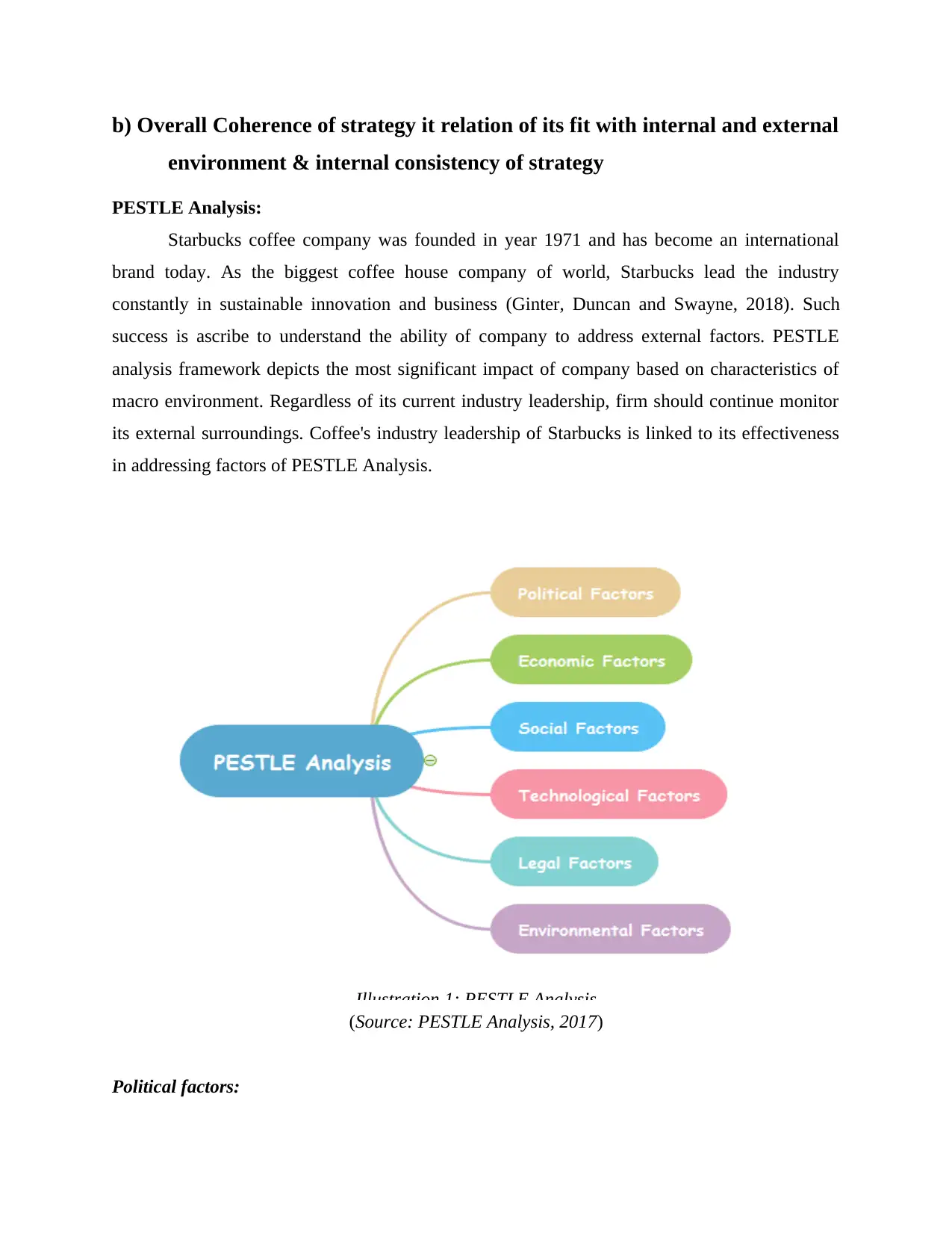
b) Overall Coherence of strategy it relation of its fit with internal and external
environment & internal consistency of strategy
PESTLE Analysis:
Starbucks coffee company was founded in year 1971 and has become an international
brand today. As the biggest coffee house company of world, Starbucks lead the industry
constantly in sustainable innovation and business (Ginter, Duncan and Swayne, 2018). Such
success is ascribe to understand the ability of company to address external factors. PESTLE
analysis framework depicts the most significant impact of company based on characteristics of
macro environment. Regardless of its current industry leadership, firm should continue monitor
its external surroundings. Coffee's industry leadership of Starbucks is linked to its effectiveness
in addressing factors of PESTLE Analysis.
(Source: PESTLE Analysis, 2017)
Political factors:
Illustration 1: PESTLE Analysis
environment & internal consistency of strategy
PESTLE Analysis:
Starbucks coffee company was founded in year 1971 and has become an international
brand today. As the biggest coffee house company of world, Starbucks lead the industry
constantly in sustainable innovation and business (Ginter, Duncan and Swayne, 2018). Such
success is ascribe to understand the ability of company to address external factors. PESTLE
analysis framework depicts the most significant impact of company based on characteristics of
macro environment. Regardless of its current industry leadership, firm should continue monitor
its external surroundings. Coffee's industry leadership of Starbucks is linked to its effectiveness
in addressing factors of PESTLE Analysis.
(Source: PESTLE Analysis, 2017)
Political factors:
Illustration 1: PESTLE Analysis
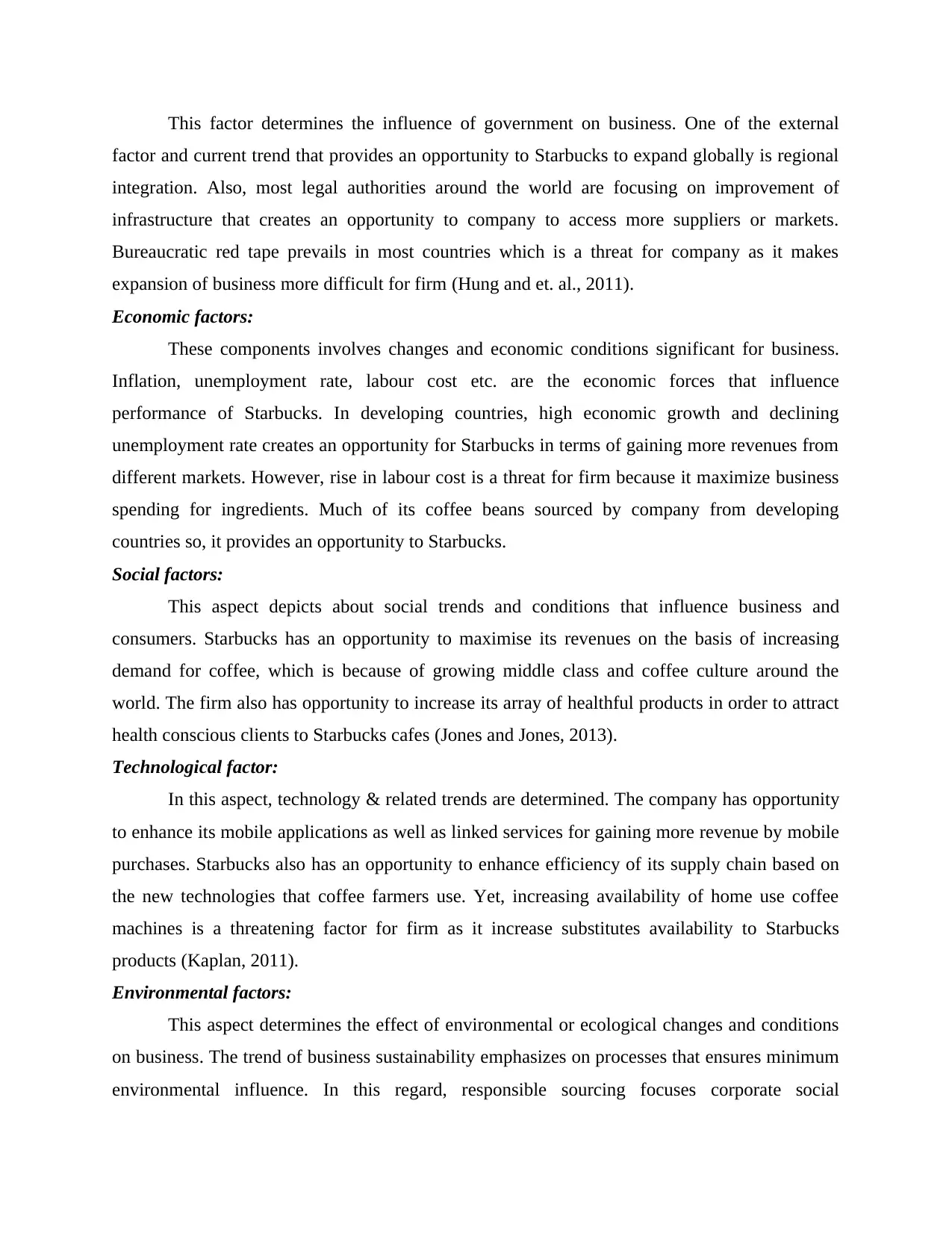
This factor determines the influence of government on business. One of the external
factor and current trend that provides an opportunity to Starbucks to expand globally is regional
integration. Also, most legal authorities around the world are focusing on improvement of
infrastructure that creates an opportunity to company to access more suppliers or markets.
Bureaucratic red tape prevails in most countries which is a threat for company as it makes
expansion of business more difficult for firm (Hung and et. al., 2011).
Economic factors:
These components involves changes and economic conditions significant for business.
Inflation, unemployment rate, labour cost etc. are the economic forces that influence
performance of Starbucks. In developing countries, high economic growth and declining
unemployment rate creates an opportunity for Starbucks in terms of gaining more revenues from
different markets. However, rise in labour cost is a threat for firm because it maximize business
spending for ingredients. Much of its coffee beans sourced by company from developing
countries so, it provides an opportunity to Starbucks.
Social factors:
This aspect depicts about social trends and conditions that influence business and
consumers. Starbucks has an opportunity to maximise its revenues on the basis of increasing
demand for coffee, which is because of growing middle class and coffee culture around the
world. The firm also has opportunity to increase its array of healthful products in order to attract
health conscious clients to Starbucks cafes (Jones and Jones, 2013).
Technological factor:
In this aspect, technology & related trends are determined. The company has opportunity
to enhance its mobile applications as well as linked services for gaining more revenue by mobile
purchases. Starbucks also has an opportunity to enhance efficiency of its supply chain based on
the new technologies that coffee farmers use. Yet, increasing availability of home use coffee
machines is a threatening factor for firm as it increase substitutes availability to Starbucks
products (Kaplan, 2011).
Environmental factors:
This aspect determines the effect of environmental or ecological changes and conditions
on business. The trend of business sustainability emphasizes on processes that ensures minimum
environmental influence. In this regard, responsible sourcing focuses corporate social
factor and current trend that provides an opportunity to Starbucks to expand globally is regional
integration. Also, most legal authorities around the world are focusing on improvement of
infrastructure that creates an opportunity to company to access more suppliers or markets.
Bureaucratic red tape prevails in most countries which is a threat for company as it makes
expansion of business more difficult for firm (Hung and et. al., 2011).
Economic factors:
These components involves changes and economic conditions significant for business.
Inflation, unemployment rate, labour cost etc. are the economic forces that influence
performance of Starbucks. In developing countries, high economic growth and declining
unemployment rate creates an opportunity for Starbucks in terms of gaining more revenues from
different markets. However, rise in labour cost is a threat for firm because it maximize business
spending for ingredients. Much of its coffee beans sourced by company from developing
countries so, it provides an opportunity to Starbucks.
Social factors:
This aspect depicts about social trends and conditions that influence business and
consumers. Starbucks has an opportunity to maximise its revenues on the basis of increasing
demand for coffee, which is because of growing middle class and coffee culture around the
world. The firm also has opportunity to increase its array of healthful products in order to attract
health conscious clients to Starbucks cafes (Jones and Jones, 2013).
Technological factor:
In this aspect, technology & related trends are determined. The company has opportunity
to enhance its mobile applications as well as linked services for gaining more revenue by mobile
purchases. Starbucks also has an opportunity to enhance efficiency of its supply chain based on
the new technologies that coffee farmers use. Yet, increasing availability of home use coffee
machines is a threatening factor for firm as it increase substitutes availability to Starbucks
products (Kaplan, 2011).
Environmental factors:
This aspect determines the effect of environmental or ecological changes and conditions
on business. The trend of business sustainability emphasizes on processes that ensures minimum
environmental influence. In this regard, responsible sourcing focuses corporate social
⊘ This is a preview!⊘
Do you want full access?
Subscribe today to unlock all pages.

Trusted by 1+ million students worldwide
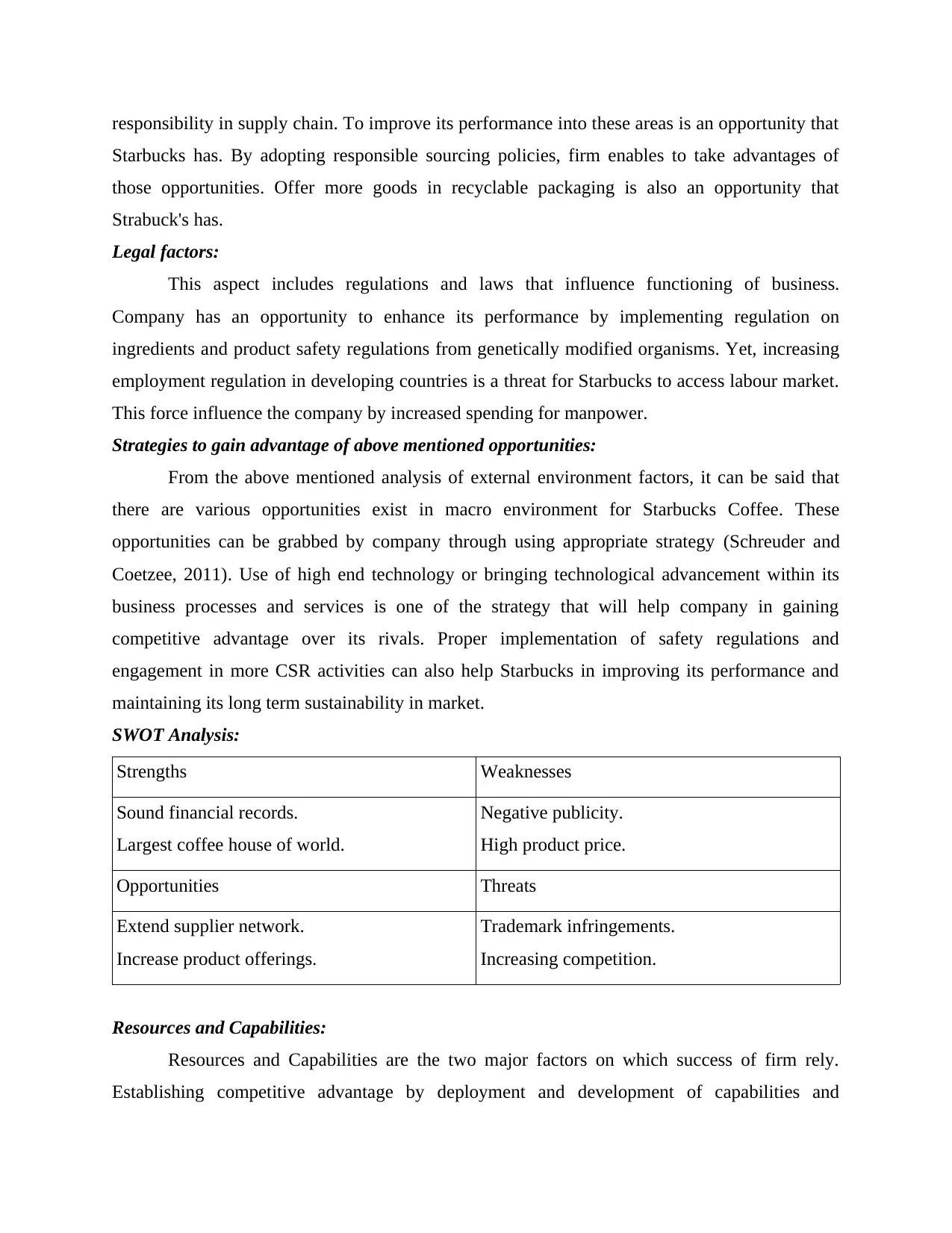
responsibility in supply chain. To improve its performance into these areas is an opportunity that
Starbucks has. By adopting responsible sourcing policies, firm enables to take advantages of
those opportunities. Offer more goods in recyclable packaging is also an opportunity that
Strabuck's has.
Legal factors:
This aspect includes regulations and laws that influence functioning of business.
Company has an opportunity to enhance its performance by implementing regulation on
ingredients and product safety regulations from genetically modified organisms. Yet, increasing
employment regulation in developing countries is a threat for Starbucks to access labour market.
This force influence the company by increased spending for manpower.
Strategies to gain advantage of above mentioned opportunities:
From the above mentioned analysis of external environment factors, it can be said that
there are various opportunities exist in macro environment for Starbucks Coffee. These
opportunities can be grabbed by company through using appropriate strategy (Schreuder and
Coetzee, 2011). Use of high end technology or bringing technological advancement within its
business processes and services is one of the strategy that will help company in gaining
competitive advantage over its rivals. Proper implementation of safety regulations and
engagement in more CSR activities can also help Starbucks in improving its performance and
maintaining its long term sustainability in market.
SWOT Analysis:
Strengths Weaknesses
Sound financial records.
Largest coffee house of world.
Negative publicity.
High product price.
Opportunities Threats
Extend supplier network.
Increase product offerings.
Trademark infringements.
Increasing competition.
Resources and Capabilities:
Resources and Capabilities are the two major factors on which success of firm rely.
Establishing competitive advantage by deployment and development of capabilities and
Starbucks has. By adopting responsible sourcing policies, firm enables to take advantages of
those opportunities. Offer more goods in recyclable packaging is also an opportunity that
Strabuck's has.
Legal factors:
This aspect includes regulations and laws that influence functioning of business.
Company has an opportunity to enhance its performance by implementing regulation on
ingredients and product safety regulations from genetically modified organisms. Yet, increasing
employment regulation in developing countries is a threat for Starbucks to access labour market.
This force influence the company by increased spending for manpower.
Strategies to gain advantage of above mentioned opportunities:
From the above mentioned analysis of external environment factors, it can be said that
there are various opportunities exist in macro environment for Starbucks Coffee. These
opportunities can be grabbed by company through using appropriate strategy (Schreuder and
Coetzee, 2011). Use of high end technology or bringing technological advancement within its
business processes and services is one of the strategy that will help company in gaining
competitive advantage over its rivals. Proper implementation of safety regulations and
engagement in more CSR activities can also help Starbucks in improving its performance and
maintaining its long term sustainability in market.
SWOT Analysis:
Strengths Weaknesses
Sound financial records.
Largest coffee house of world.
Negative publicity.
High product price.
Opportunities Threats
Extend supplier network.
Increase product offerings.
Trademark infringements.
Increasing competition.
Resources and Capabilities:
Resources and Capabilities are the two major factors on which success of firm rely.
Establishing competitive advantage by deployment and development of capabilities and
Paraphrase This Document
Need a fresh take? Get an instant paraphrase of this document with our AI Paraphraser
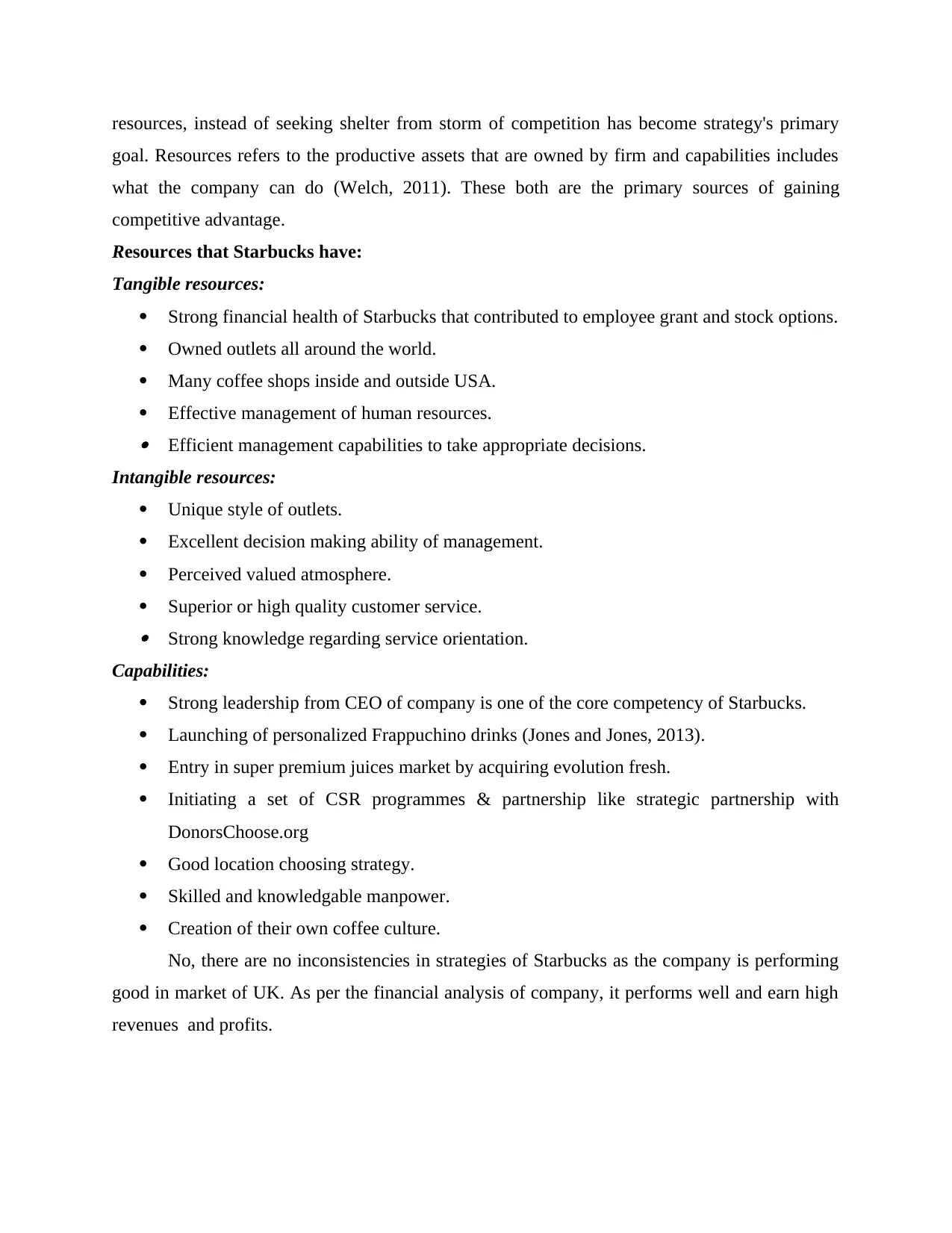
resources, instead of seeking shelter from storm of competition has become strategy's primary
goal. Resources refers to the productive assets that are owned by firm and capabilities includes
what the company can do (Welch, 2011). These both are the primary sources of gaining
competitive advantage.
Resources that Starbucks have:
Tangible resources:
Strong financial health of Starbucks that contributed to employee grant and stock options.
Owned outlets all around the world.
Many coffee shops inside and outside USA.
Effective management of human resources. Efficient management capabilities to take appropriate decisions.
Intangible resources:
Unique style of outlets.
Excellent decision making ability of management.
Perceived valued atmosphere.
Superior or high quality customer service. Strong knowledge regarding service orientation.
Capabilities:
Strong leadership from CEO of company is one of the core competency of Starbucks.
Launching of personalized Frappuchino drinks (Jones and Jones, 2013).
Entry in super premium juices market by acquiring evolution fresh.
Initiating a set of CSR programmes & partnership like strategic partnership with
DonorsChoose.org
Good location choosing strategy.
Skilled and knowledgable manpower.
Creation of their own coffee culture.
No, there are no inconsistencies in strategies of Starbucks as the company is performing
good in market of UK. As per the financial analysis of company, it performs well and earn high
revenues and profits.
goal. Resources refers to the productive assets that are owned by firm and capabilities includes
what the company can do (Welch, 2011). These both are the primary sources of gaining
competitive advantage.
Resources that Starbucks have:
Tangible resources:
Strong financial health of Starbucks that contributed to employee grant and stock options.
Owned outlets all around the world.
Many coffee shops inside and outside USA.
Effective management of human resources. Efficient management capabilities to take appropriate decisions.
Intangible resources:
Unique style of outlets.
Excellent decision making ability of management.
Perceived valued atmosphere.
Superior or high quality customer service. Strong knowledge regarding service orientation.
Capabilities:
Strong leadership from CEO of company is one of the core competency of Starbucks.
Launching of personalized Frappuchino drinks (Jones and Jones, 2013).
Entry in super premium juices market by acquiring evolution fresh.
Initiating a set of CSR programmes & partnership like strategic partnership with
DonorsChoose.org
Good location choosing strategy.
Skilled and knowledgable manpower.
Creation of their own coffee culture.
No, there are no inconsistencies in strategies of Starbucks as the company is performing
good in market of UK. As per the financial analysis of company, it performs well and earn high
revenues and profits.
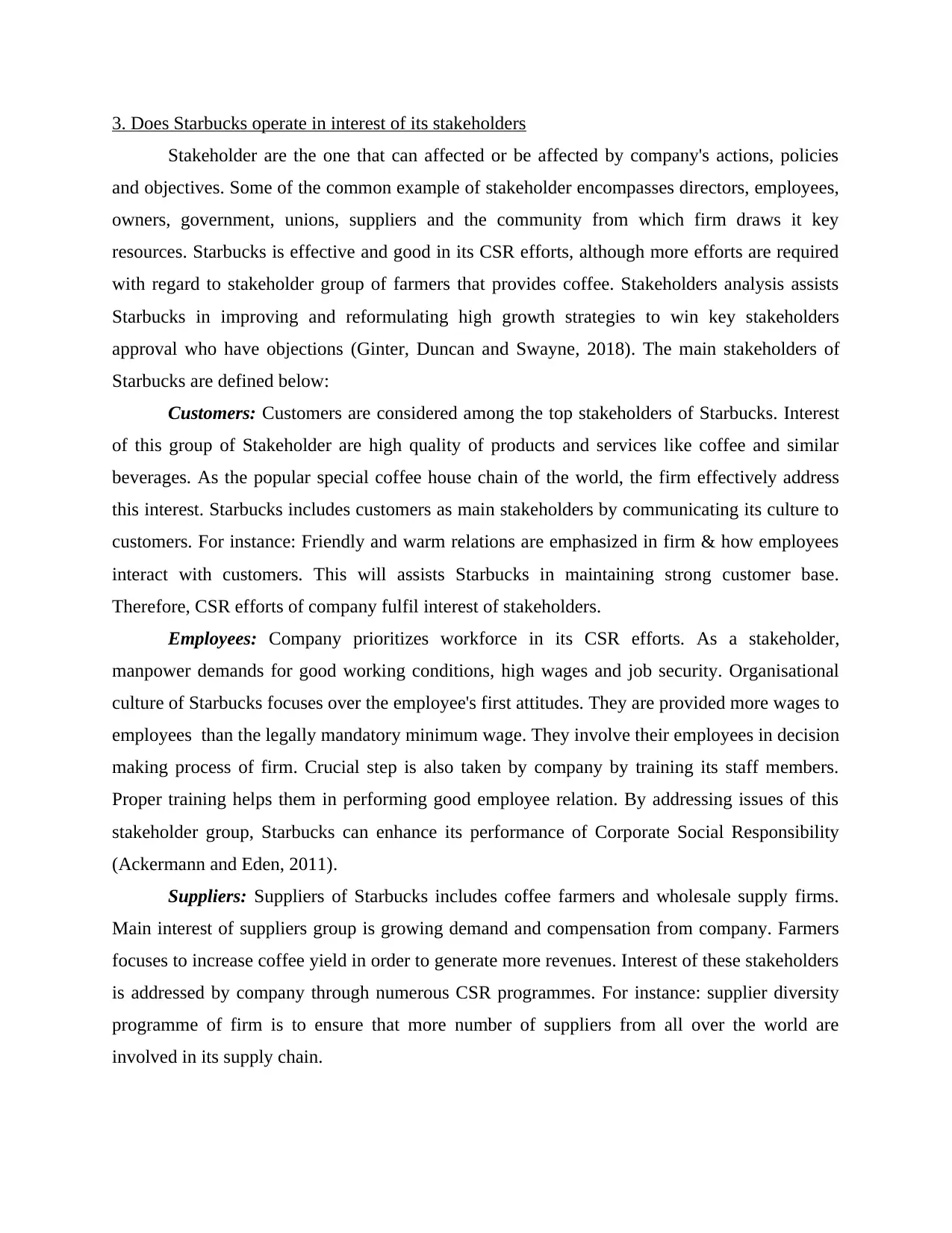
3. Does Starbucks operate in interest of its stakeholders
Stakeholder are the one that can affected or be affected by company's actions, policies
and objectives. Some of the common example of stakeholder encompasses directors, employees,
owners, government, unions, suppliers and the community from which firm draws it key
resources. Starbucks is effective and good in its CSR efforts, although more efforts are required
with regard to stakeholder group of farmers that provides coffee. Stakeholders analysis assists
Starbucks in improving and reformulating high growth strategies to win key stakeholders
approval who have objections (Ginter, Duncan and Swayne, 2018). The main stakeholders of
Starbucks are defined below:
Customers: Customers are considered among the top stakeholders of Starbucks. Interest
of this group of Stakeholder are high quality of products and services like coffee and similar
beverages. As the popular special coffee house chain of the world, the firm effectively address
this interest. Starbucks includes customers as main stakeholders by communicating its culture to
customers. For instance: Friendly and warm relations are emphasized in firm & how employees
interact with customers. This will assists Starbucks in maintaining strong customer base.
Therefore, CSR efforts of company fulfil interest of stakeholders.
Employees: Company prioritizes workforce in its CSR efforts. As a stakeholder,
manpower demands for good working conditions, high wages and job security. Organisational
culture of Starbucks focuses over the employee's first attitudes. They are provided more wages to
employees than the legally mandatory minimum wage. They involve their employees in decision
making process of firm. Crucial step is also taken by company by training its staff members.
Proper training helps them in performing good employee relation. By addressing issues of this
stakeholder group, Starbucks can enhance its performance of Corporate Social Responsibility
(Ackermann and Eden, 2011).
Suppliers: Suppliers of Starbucks includes coffee farmers and wholesale supply firms.
Main interest of suppliers group is growing demand and compensation from company. Farmers
focuses to increase coffee yield in order to generate more revenues. Interest of these stakeholders
is addressed by company through numerous CSR programmes. For instance: supplier diversity
programme of firm is to ensure that more number of suppliers from all over the world are
involved in its supply chain.
Stakeholder are the one that can affected or be affected by company's actions, policies
and objectives. Some of the common example of stakeholder encompasses directors, employees,
owners, government, unions, suppliers and the community from which firm draws it key
resources. Starbucks is effective and good in its CSR efforts, although more efforts are required
with regard to stakeholder group of farmers that provides coffee. Stakeholders analysis assists
Starbucks in improving and reformulating high growth strategies to win key stakeholders
approval who have objections (Ginter, Duncan and Swayne, 2018). The main stakeholders of
Starbucks are defined below:
Customers: Customers are considered among the top stakeholders of Starbucks. Interest
of this group of Stakeholder are high quality of products and services like coffee and similar
beverages. As the popular special coffee house chain of the world, the firm effectively address
this interest. Starbucks includes customers as main stakeholders by communicating its culture to
customers. For instance: Friendly and warm relations are emphasized in firm & how employees
interact with customers. This will assists Starbucks in maintaining strong customer base.
Therefore, CSR efforts of company fulfil interest of stakeholders.
Employees: Company prioritizes workforce in its CSR efforts. As a stakeholder,
manpower demands for good working conditions, high wages and job security. Organisational
culture of Starbucks focuses over the employee's first attitudes. They are provided more wages to
employees than the legally mandatory minimum wage. They involve their employees in decision
making process of firm. Crucial step is also taken by company by training its staff members.
Proper training helps them in performing good employee relation. By addressing issues of this
stakeholder group, Starbucks can enhance its performance of Corporate Social Responsibility
(Ackermann and Eden, 2011).
Suppliers: Suppliers of Starbucks includes coffee farmers and wholesale supply firms.
Main interest of suppliers group is growing demand and compensation from company. Farmers
focuses to increase coffee yield in order to generate more revenues. Interest of these stakeholders
is addressed by company through numerous CSR programmes. For instance: supplier diversity
programme of firm is to ensure that more number of suppliers from all over the world are
involved in its supply chain.
⊘ This is a preview!⊘
Do you want full access?
Subscribe today to unlock all pages.

Trusted by 1+ million students worldwide
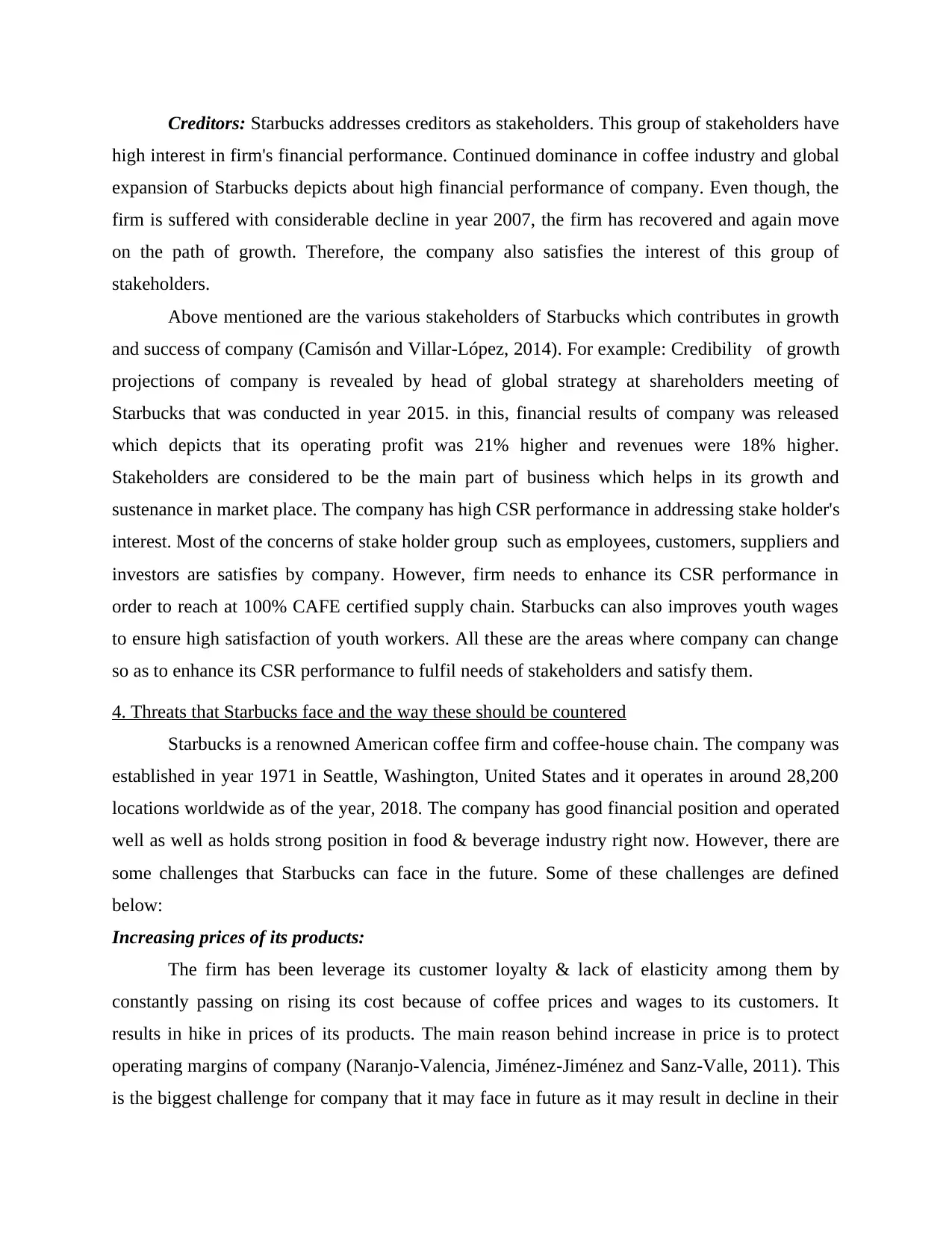
Creditors: Starbucks addresses creditors as stakeholders. This group of stakeholders have
high interest in firm's financial performance. Continued dominance in coffee industry and global
expansion of Starbucks depicts about high financial performance of company. Even though, the
firm is suffered with considerable decline in year 2007, the firm has recovered and again move
on the path of growth. Therefore, the company also satisfies the interest of this group of
stakeholders.
Above mentioned are the various stakeholders of Starbucks which contributes in growth
and success of company (Camisón and Villar-López, 2014). For example: Credibility of growth
projections of company is revealed by head of global strategy at shareholders meeting of
Starbucks that was conducted in year 2015. in this, financial results of company was released
which depicts that its operating profit was 21% higher and revenues were 18% higher.
Stakeholders are considered to be the main part of business which helps in its growth and
sustenance in market place. The company has high CSR performance in addressing stake holder's
interest. Most of the concerns of stake holder group such as employees, customers, suppliers and
investors are satisfies by company. However, firm needs to enhance its CSR performance in
order to reach at 100% CAFE certified supply chain. Starbucks can also improves youth wages
to ensure high satisfaction of youth workers. All these are the areas where company can change
so as to enhance its CSR performance to fulfil needs of stakeholders and satisfy them.
4. Threats that Starbucks face and the way these should be countered
Starbucks is a renowned American coffee firm and coffee-house chain. The company was
established in year 1971 in Seattle, Washington, United States and it operates in around 28,200
locations worldwide as of the year, 2018. The company has good financial position and operated
well as well as holds strong position in food & beverage industry right now. However, there are
some challenges that Starbucks can face in the future. Some of these challenges are defined
below:
Increasing prices of its products:
The firm has been leverage its customer loyalty & lack of elasticity among them by
constantly passing on rising its cost because of coffee prices and wages to its customers. It
results in hike in prices of its products. The main reason behind increase in price is to protect
operating margins of company (Naranjo-Valencia, Jiménez-Jiménez and Sanz-Valle, 2011). This
is the biggest challenge for company that it may face in future as it may result in decline in their
high interest in firm's financial performance. Continued dominance in coffee industry and global
expansion of Starbucks depicts about high financial performance of company. Even though, the
firm is suffered with considerable decline in year 2007, the firm has recovered and again move
on the path of growth. Therefore, the company also satisfies the interest of this group of
stakeholders.
Above mentioned are the various stakeholders of Starbucks which contributes in growth
and success of company (Camisón and Villar-López, 2014). For example: Credibility of growth
projections of company is revealed by head of global strategy at shareholders meeting of
Starbucks that was conducted in year 2015. in this, financial results of company was released
which depicts that its operating profit was 21% higher and revenues were 18% higher.
Stakeholders are considered to be the main part of business which helps in its growth and
sustenance in market place. The company has high CSR performance in addressing stake holder's
interest. Most of the concerns of stake holder group such as employees, customers, suppliers and
investors are satisfies by company. However, firm needs to enhance its CSR performance in
order to reach at 100% CAFE certified supply chain. Starbucks can also improves youth wages
to ensure high satisfaction of youth workers. All these are the areas where company can change
so as to enhance its CSR performance to fulfil needs of stakeholders and satisfy them.
4. Threats that Starbucks face and the way these should be countered
Starbucks is a renowned American coffee firm and coffee-house chain. The company was
established in year 1971 in Seattle, Washington, United States and it operates in around 28,200
locations worldwide as of the year, 2018. The company has good financial position and operated
well as well as holds strong position in food & beverage industry right now. However, there are
some challenges that Starbucks can face in the future. Some of these challenges are defined
below:
Increasing prices of its products:
The firm has been leverage its customer loyalty & lack of elasticity among them by
constantly passing on rising its cost because of coffee prices and wages to its customers. It
results in hike in prices of its products. The main reason behind increase in price is to protect
operating margins of company (Naranjo-Valencia, Jiménez-Jiménez and Sanz-Valle, 2011). This
is the biggest challenge for company that it may face in future as it may result in decline in their
Paraphrase This Document
Need a fresh take? Get an instant paraphrase of this document with our AI Paraphraser
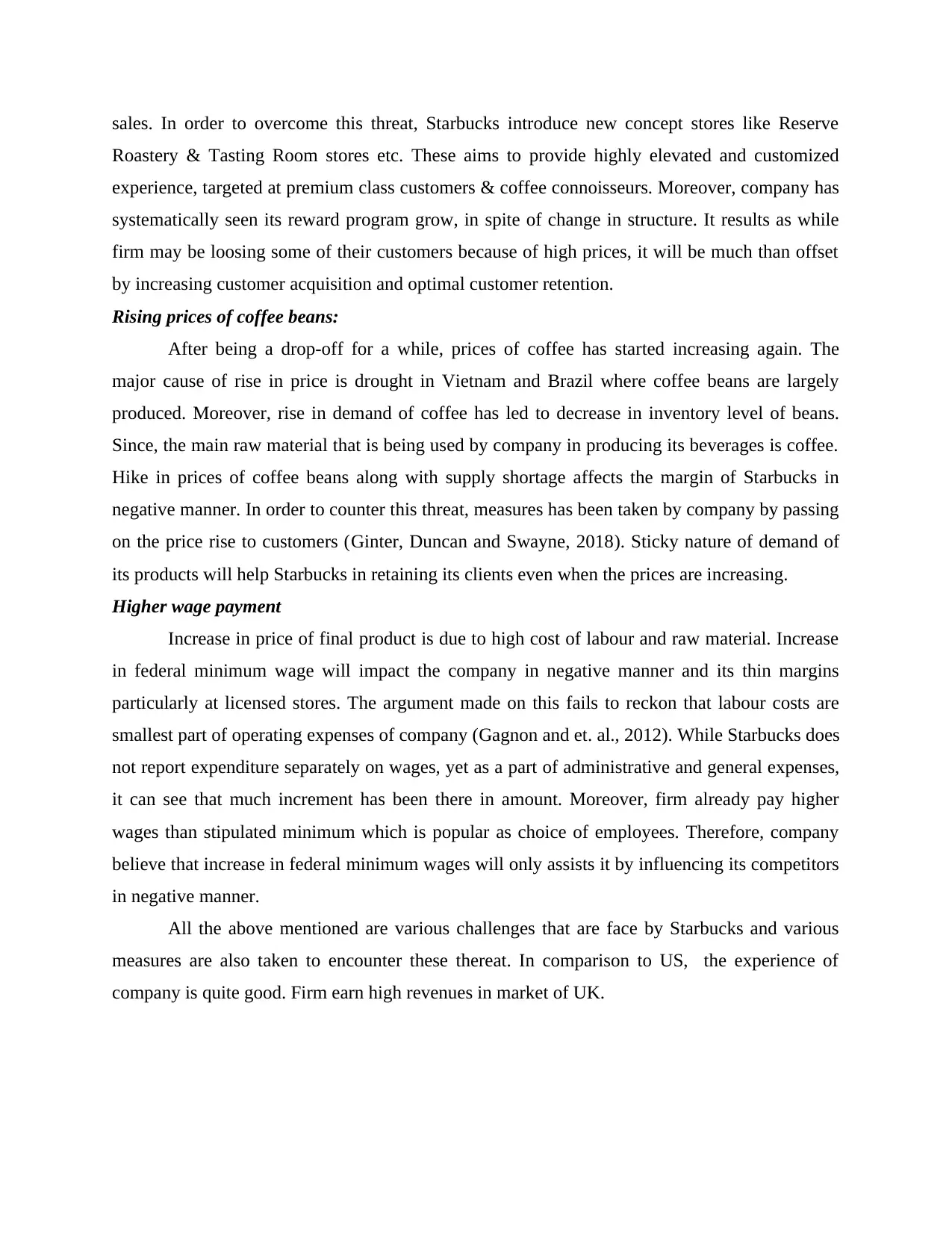
sales. In order to overcome this threat, Starbucks introduce new concept stores like Reserve
Roastery & Tasting Room stores etc. These aims to provide highly elevated and customized
experience, targeted at premium class customers & coffee connoisseurs. Moreover, company has
systematically seen its reward program grow, in spite of change in structure. It results as while
firm may be loosing some of their customers because of high prices, it will be much than offset
by increasing customer acquisition and optimal customer retention.
Rising prices of coffee beans:
After being a drop-off for a while, prices of coffee has started increasing again. The
major cause of rise in price is drought in Vietnam and Brazil where coffee beans are largely
produced. Moreover, rise in demand of coffee has led to decrease in inventory level of beans.
Since, the main raw material that is being used by company in producing its beverages is coffee.
Hike in prices of coffee beans along with supply shortage affects the margin of Starbucks in
negative manner. In order to counter this threat, measures has been taken by company by passing
on the price rise to customers (Ginter, Duncan and Swayne, 2018). Sticky nature of demand of
its products will help Starbucks in retaining its clients even when the prices are increasing.
Higher wage payment
Increase in price of final product is due to high cost of labour and raw material. Increase
in federal minimum wage will impact the company in negative manner and its thin margins
particularly at licensed stores. The argument made on this fails to reckon that labour costs are
smallest part of operating expenses of company (Gagnon and et. al., 2012). While Starbucks does
not report expenditure separately on wages, yet as a part of administrative and general expenses,
it can see that much increment has been there in amount. Moreover, firm already pay higher
wages than stipulated minimum which is popular as choice of employees. Therefore, company
believe that increase in federal minimum wages will only assists it by influencing its competitors
in negative manner.
All the above mentioned are various challenges that are face by Starbucks and various
measures are also taken to encounter these thereat. In comparison to US, the experience of
company is quite good. Firm earn high revenues in market of UK.
Roastery & Tasting Room stores etc. These aims to provide highly elevated and customized
experience, targeted at premium class customers & coffee connoisseurs. Moreover, company has
systematically seen its reward program grow, in spite of change in structure. It results as while
firm may be loosing some of their customers because of high prices, it will be much than offset
by increasing customer acquisition and optimal customer retention.
Rising prices of coffee beans:
After being a drop-off for a while, prices of coffee has started increasing again. The
major cause of rise in price is drought in Vietnam and Brazil where coffee beans are largely
produced. Moreover, rise in demand of coffee has led to decrease in inventory level of beans.
Since, the main raw material that is being used by company in producing its beverages is coffee.
Hike in prices of coffee beans along with supply shortage affects the margin of Starbucks in
negative manner. In order to counter this threat, measures has been taken by company by passing
on the price rise to customers (Ginter, Duncan and Swayne, 2018). Sticky nature of demand of
its products will help Starbucks in retaining its clients even when the prices are increasing.
Higher wage payment
Increase in price of final product is due to high cost of labour and raw material. Increase
in federal minimum wage will impact the company in negative manner and its thin margins
particularly at licensed stores. The argument made on this fails to reckon that labour costs are
smallest part of operating expenses of company (Gagnon and et. al., 2012). While Starbucks does
not report expenditure separately on wages, yet as a part of administrative and general expenses,
it can see that much increment has been there in amount. Moreover, firm already pay higher
wages than stipulated minimum which is popular as choice of employees. Therefore, company
believe that increase in federal minimum wages will only assists it by influencing its competitors
in negative manner.
All the above mentioned are various challenges that are face by Starbucks and various
measures are also taken to encounter these thereat. In comparison to US, the experience of
company is quite good. Firm earn high revenues in market of UK.

⊘ This is a preview!⊘
Do you want full access?
Subscribe today to unlock all pages.

Trusted by 1+ million students worldwide
1 out of 13
Related Documents
Your All-in-One AI-Powered Toolkit for Academic Success.
+13062052269
info@desklib.com
Available 24*7 on WhatsApp / Email
![[object Object]](/_next/static/media/star-bottom.7253800d.svg)
Unlock your academic potential
Copyright © 2020–2025 A2Z Services. All Rights Reserved. Developed and managed by ZUCOL.





